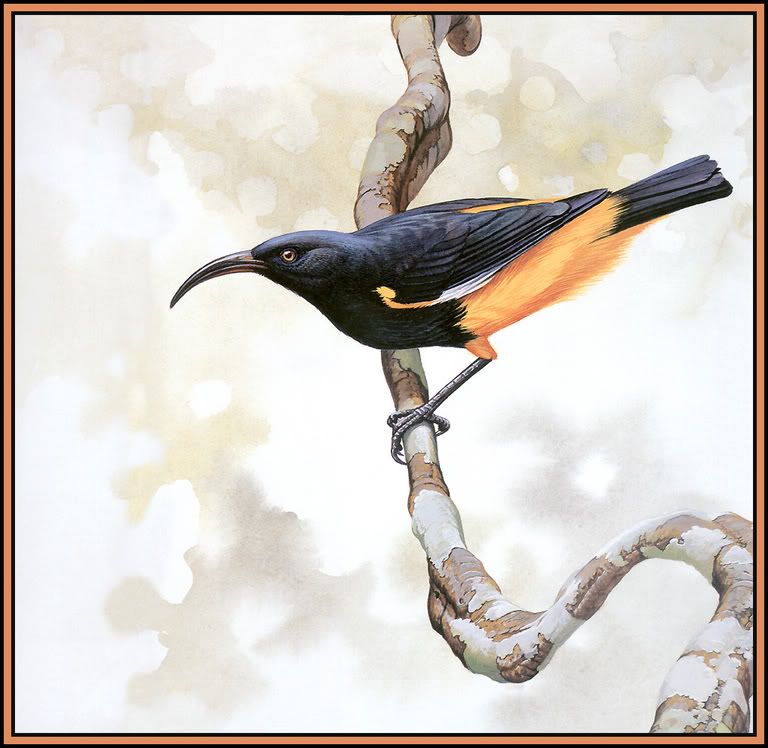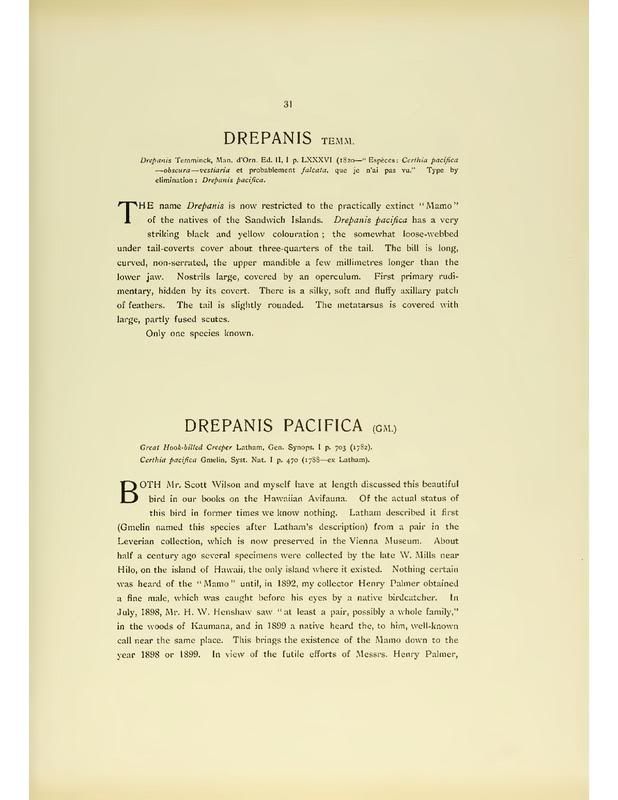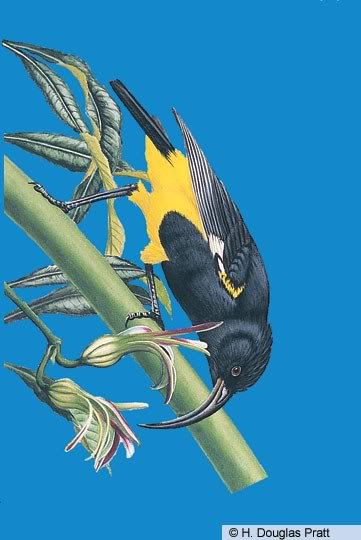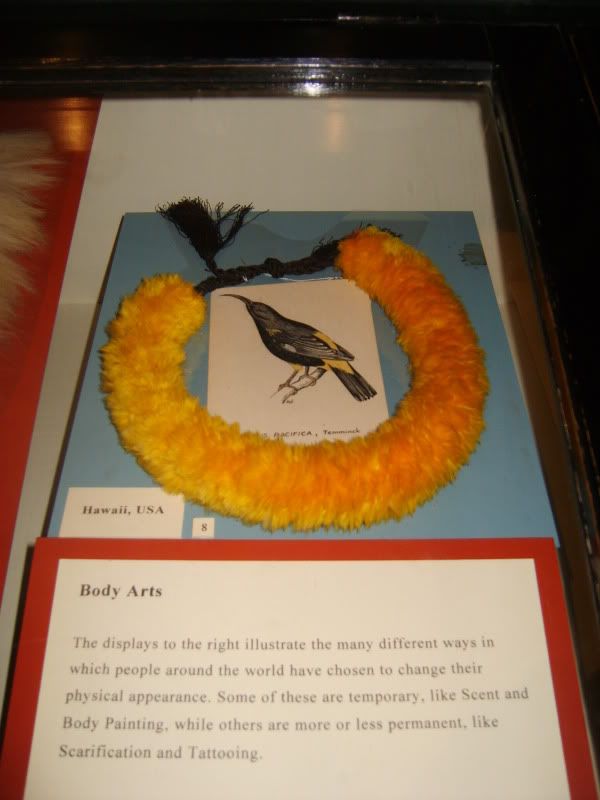|
|
Post by Melanie on May 31, 2005 1:59:32 GMT
HAWAI'I MAMO (Drepanis pacifica) Ex Formerly Endemic to Hawai'i. Last taken on 16th April 1892 and last seen in 1899. The Hawaiian name MAMO or HOOHOO is probably a corruption of the similar 'O'o, which is also black with yellow. Adults were glossy black with yellow rumps and thigh feathers and small yellow shoulder patch. The tail was black and there was a white basal primary patch and white shafts along the primaries. The bill was long and decurved and black. Legs were dark gray or black. (9 inches) Call: A long, plaintive whistle. This was a shy species that lived in the forest canopy and fed on nectar of lobelioid flowers that possessed curved, tubular flowers. Last seen near Kaumana on Hawai'i. The royal cloak of Kamehameha I is estimated to have taken the reigns of eight monarchs and the feathers of 80,000 Mamos before it was completed!  |
|
|
|
Post by another specialist on Jun 7, 2005 6:40:07 GMT
|
|
|
|
Post by another specialist on Jun 8, 2005 4:00:28 GMT
|
|
Deleted
Deleted Member
Posts: 0
|
Post by Deleted on Nov 1, 2005 17:54:36 GMT
Hi ! Very bad picture:  Bye Alex |
|
|
|
Post by another specialist on Nov 3, 2005 8:25:31 GMT
|
|
|
|
Post by another specialist on Nov 6, 2005 19:17:37 GMT
 gap in nature |
|
|
|
Post by extinctionier on Nov 6, 2005 21:31:08 GMT
They have a nice photo of the holotype in the book "Rarest of the Rare", as well as Thylacines, dodos, Elephants Birds, Xerces Blue, Carolina Parakeet, Stellar's Seacow, and the Cape Verde Giant Skink.
|
|
|
|
Post by another specialist on Nov 7, 2005 7:34:23 GMT
thanks for informing us - going to see if i can get a copy
|
|
|
|
Post by another specialist on Jul 16, 2008 9:16:07 GMT
  Extinct birds : an attempt to unite in one volume a short account of those birds which have become extinct in historical times : that is, within the last six or seven hundred years : to which are added a few which still exist, but are on the verge of extinction (1907) |
|
|
|
Post by another specialist on Sept 13, 2008 21:12:14 GMT
|
|
Deleted
Deleted Member
Posts: 0
|
Post by Deleted on Sept 15, 2008 16:08:54 GMT
Hawai'i Mamo ( Drepanis pacifica)  scanned from H. Douglas Pratt: 'The Hawaiian Honeycreepers, Drepanidinae |
|
|
|
Post by another specialist on Sept 16, 2008 5:59:33 GMT
|
|
|
|
Post by another specialist on Nov 28, 2008 6:45:47 GMT
 The mamos were large Hawaiian honeycreepers with very long, sickle- shaped bills adapted for feeding on nectar. The Hawai‘i Mamo was one of the first Hawaiian honeycreepers to be observed by Europeans and became the namesake of the entire subfamily Drepanidinae. Although rare by the time most European collectors arrived, the Hawai‘i Mamo holds a prominent place in Hawaiian culture. It was an important source of black and yellow feathers used to make the exquisite feather cloaks called ahu-ula worn by Hawaiian nobility or ali‘i . In fact, mamo was an alternative name for such cloaks (Bird 1881). According to Buck (1964b), the name ahu-ula literally means “red garment,” and reflects the fact that throughout Polynesia, red is considered the chiefly color; but in the Hawaiian Islands, perhaps because of the relative scarcity of yellow feathers, yellow became more prestigious. The yellow feathers of the Hawai‘i Mamo were preferred to those of ‘ö‘ös (Moho spp.) and other birds because of their richer color and probably because they were more difficult to obtain. Those from the flanks and rump were called ko‘o mamo while those from the thighs were called ‘ae mamo (Buck 1964b). According to Wilson and Evans (1890–1899), among the larger feather cloaks in the British Museum of Natural History, diamond-shaped patterns of these darker yellow feathers are interspersed among the more abundant, paler yellow feathers. One cloak is entirely of Hawai‘i Mamo feathers (including black) and is about a meter at its largest dimension. Most notable of all is the so-called “million dollar cloak,” now in the Bishop Museum, that belonged to Kamehameha the Great. It contains about 450,000 mamo feathers. As Buck (1964b: 231) states, so many feathers could only have been amassed by a conqueror “who could gather up the stock in the possession of the other kings and high chiefs.” Hawai‘i Mamo feathers were also used to make leis worn by female ali‘i . The most valuable of these, a strand about 61 cm long and 6.5 cm in diameter housed in the Bishop Museum, also belonged to the Kamehameha family and is a composite of 3 older leis (Buck 1964a). Mamo feathers could well be considered the “crown jewels” of Hawai‘i. Ancient bird-catchers captured the birds alive using a sticky birdlime smeared on branches near flowers likely to be visited by nectarivores. Another method was to lie in concealment and hold a flower of the favored type. When the bird inserted its bill into the corolla, it could be seized (Townsend 1839, Perkins 1903). Perhaps as an early conservation measure, mamos and ‘o‘os were kapu (taboo) as food; they “were caught in the moulting season, the yellow feathers were plucked out, and the birds set free to grow another crop for the next season” (Buck 1964b: 217). Whether a Hawai‘i Mamo could really survive the loss of so many feathers at once is not known, and some authors question whether captured birds were actually released rather than eaten (see summary in Rose et al. 1993). The Black Mamo was one of the last Hawaiian honeycreepers discovered and one of the least colorful, in contrast to the Hawai‘i Mamo. The little we know of the Black Mamo comes mainly from R. C. L. Perkins, who discovered the species on Moloka‘i in 1893, and William Alanson Bryan, who collected the last specimens in 1907. Berger (1981) lampooned Bryan’s (1908) zeal as a collector as if it amounted to wanton slaughter. But collectors of that era were clearly dismayed by the ongoing mysterious and seemingly inevitable disappearance of Hawai‘i’s endemic birds. We are indebted to them for saving what they could before it was too late. Mearns and Mearns (1992: 325) accurately state, “The extirpation of many of the forest birds of the Hawaiian Islands has been caused by the destruction of habitat, the introduction of ground predators and by mosquito-borne diseases, three factors that continue to be a problem and are likely to lead to further extinctions. The collecting activities of the early naturalists had little effect on the bird populations and but for their efforts some species would not be known to us at all.” The ‘Ula-‘ai-häwane is probably the least known Hawaiian honeycreeper and the only one that was never certainly observed in life by any western ornithologist. The 5 historical specimens were all collected by Hawaiian hunters. The species was described in 1878 by Sanford B. Dole as part of his review of the J. D. Mills collection in Hilo. An amateur naturalist and lifelong corresponding member of the American Ornithologists’ Union, Dole is a prominent figure in Hawaiian history whose life provides an ornithological connection to the annexation of the islands by the United States. He went on to become a legislator in the Kingdom of Hawai‘i, an activist in the overthrow of the monarchy, President of the Republic, the first governor of the Territory of Hawai‘i, and a U.S. District Judge. He was instrumental in adding the Mills collection to the holdings of the newly founded Bernice Pauahi Bishop Museum in Honolulu (biographical data from Mearns and Mearns 1992). That collection is the primary one from the 1850s and 1860s from the Island of Hawai‘i. What little we know of the ‘Ula-‘ai-häwane is based on second-hand reports of Hawaiian informants, interpretation of the 5 specimens, and prehistoric osteological remains from re-cently discovered deposits in lava tubes and other sites (James and Olson 1991, Olson and James 1991). Very little is known about the natural history of any of these species. Except for the descriptions of specimens, nothing in this account can be regarded as confirmed information, but it is all we have. bna.birds.cornell.edu/ |
|
|
|
Post by another specialist on Dec 14, 2008 6:55:29 GMT
|
|
|
|
Post by another specialist on Dec 14, 2008 20:56:41 GMT
|
|
|
|
Post by another specialist on May 27, 2009 20:08:28 GMT
My own photos taken in the Pitt River Museum in Oxford - May 27 2009 Neck piece made from the feathers of Hawaii Mamo   |
|
|
|
Post by koeiyabe on Dec 12, 2015 18:50:06 GMT
 "The Earth Extinct Fauna (in Japanese)" by Tadaaki Imaizumi (1986) |
|
|
|
Post by surroundx on Sept 19, 2016 9:00:15 GMT
|
|
|
|
Post by surroundx on Sept 26, 2016 11:20:01 GMT
|
|
|
|
Post by redpinnipedgamer on Aug 9, 2024 23:47:33 GMT
|
|